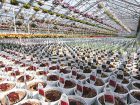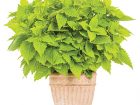
Features
Crop Culture
Inputs
Coleus: Great in garden and greenhouse
National Garden Bureau designated 2015 as Year Of The Coleus, a fitting tribute to star performer
December 9, 2014 By Dr. Rick Schoellhorn
 Dr. Rick Schoellhorn Proven Winners
Dr. Rick Schoellhorn Proven WinnersColeus is one the easiest plants for consumers to grow (and so VERY easy in commercial production), they provide season-long colour and sales and are tolerant of a wide variety of conditions, but the new cultivars that are reaching the market are far better than the old-fashioned types.
The ColorBlaze® collection, for example, was designed to offer growers and landscapers a complete and easy-to-assemble series with a full set of colours. This collection consists of nine colours, designed to provide a complete palette of colours.
Production is very straightforward, and all cultivars are easy to grow. The ColorBlaze collection was selected for late flowering so that flowers are rarely if ever seen during production or at retail.
The grower can produce coleus crops faster under warmer conditions, so consider this if placing really early season orders – since those crops will take longer to finish than they might if brought in slightly later.
Even though it is tempting, don’t keep stock from one year to the next as, especially under winter conditions, plants are more likely to harbour virus and insect problems that can affect all your crops the following spring.
TEMPERATURE IS KEY
Coleuses are tropical plants – just because they get used all over North America does not change this.
Remember that they are still a warm preference crop, so maintain crop temperatures at or above 65-72 F (18-22 C).
For almost every coleus on the market, temperatures below 40 F (4.5 C) are considered the point where chilling damage can occur. So keep plants warm at all times during production and watch for chilling damage on cuttings or liners when they arrive.
A cold coleus plant will stop growing, weaken, and is much more susceptible to insects and disease, so make sure they are not by a cold door or vent where cold air passes across the crop.
Under warm production temperatures the crop grows faster and leaf colour in general is brighter.
QUICK CROPPING IS THE BEST METHOD OF PRODUCTION
Coleus is salable as soon as leaves cover the surface of the container, so don’t try to hold them for long periods.
Root them in and move them quickly, when well grown, all of the ColorBlaze series are very fast. If you have to hold the crop for some reason, here some tips:
- You can use temperature to slow the crop but you must be careful not to overdo it.
- Remember temperature of 40 F (4.5 C) can cause chill damage, so temperatures between 50-60 F or (10-16 C) will significantly slow the growth.
- Plant growth regulators can be used to control growth but be careful of over-application as it both stunts plants after retail sale and also reduces the colour overall, too much and plants green up as well exhibiting irregular growth. (See PGR usage in production guidelines and always follow label instructions).
- Don’t try to use dry down as a way to hold the crop!
Drying out will cause coleus plants to lose their lower leaves, resulting immediately in problems with crop quality.
LIGHT LEVELS
Does coleus need shade in production? No, except under the extreme high light conditions of the Rockies. However, some cultivars need a bit more protection than others.
Coleus reacts to low light in two ways.
The first is that they stretch. The longer internodes make for a lower quality crop (this is especially true for cultivars with larger leaves).
Secondly, many will develop green margins or larger green margins under low light, reducing their colour impact.
The most light sensitive colour is the chartreuse forms which turn yellow under very bright conditions, or when adapting to an increase in light levels. Most other colours are able to handle higher light with no problems.
Use light as a growth regulator, control stretching and you end up with a higher quality plant, with better branching, and less work. Position the crop in the greenhouse so it gets strong bright light; this will always give the highest quality crop.
DISEASES AND PESTS
There is really only one potential problem with this crop and that problem is downy mildew.
Cool greenhouse conditions and less than optimal air circulation make the problem more difficult. Chartreuse and yellow forms show damage the fastest, while the darker the leaf colour the more the disease symptoms are hidden, so black to purple tones show symptoms last.
This problem is usually already in your greenhouse, left over from last year’s crop. Greenhouse hygiene can help eliminate the problem before it ever raises its head.
Make sure to clean up all debris from last season before bringing in new material for spring.
Treat your benches and sidewalks and hoses and nozzles with a greenhouse sterilant before you start production for spring and save yourself a world of headaches later in the season.
There are plenty of options from chlorine bleach to hydrogen peroxide formulations and products such as Greenshield®, but the main thing is to clean up all production areas well before planting, not so much which product you use.
You can clean out hoses and irrigation pipe by using chlorinated water (2 to 3 ppm), or products like Zerotol® that work for both algae and fungus. Always check the label for correct application rates.
FLOWERING
Flowering in coleus causes the crop to lose uniformity; it reduces branching, and essentially makes the plant unsalable at retail.
Flowering can also be due to stress to the plant as in low production temperatures, drought, or growing under short day conditions; any of these factors can induce flowering even in late-flowered cultivars.
The newer new genetics in the ColorBlaze series are selected for later flowering to avoid the entire problem.
Some of the best new breeding has come from Dr. Dave Clark at the University of Florida. He has not only spent the last 15 years selecting for coleus plants that can handle the heat, full sun and humidity of the deep south, but he has also been slowly removing all of the early flowering genetics that cause so many problems in production.
As a result, many of his cultivars are replacing old standards throughout the industry simply because they make more uniform crops, hold up better at retail, and consumers really like the low maintenance aspect of these new cultivars. In general ALL seed-produced forms of coleus are earlier blooming than the vegetative types.
Sales of the strongest colours tend to dominate in coleus (much like Ornamental Sweet potato) as bright colours tend to show up better in landscapes, but more complex colour blends are also very popular with consumers. Make sure to have a complete palette of colours available for add-on sales!
Basic cultural/growing info
- pH: (6.0 – 6.5).
- EC (2:1 Extraction Method): (0.6 – 0.9).
- Fertilization recommendations: (150-200 ppm) – avoid high urea formulations of fertilizer as this simply encourages elongation in the crop. Instead, look for a balanced high nitrate nitrogen source.
- Growing temperatures: (65-72 F or 18-22 C).
- Holding temperature: (50-60 F or 10-16 C).
- Light levels: moderate to high (2,500-5,000 foot candles).
- Water requirements: moderate to moist, avoid soggy conditions.
- Planting and timing information: spring through summer finish (southern growers will see shorter production times than what is listed).
- Finish Time 4-5”: 5-6 weeks.
- Finish Time 6”/gallon: 6-8 weeks.
- Finish Time 8”: 8-10 weeks.
- Finish Time 10-12”: 10-12 weeks.
- Pinching/growth regulators: One to two pinches can be used to increase branching and for shaping.
For small pot sizes, this may not be necessary, larger pots will probably require pinching. Florel can increase branching and reduce flowering. Cycocel/B-Nine tank mix or Sumagic spray at 3-5 ppm will help control growth if needed.
USE CARE WITH PGRs! If over-applied they tend to cause overall foliage greening and loss of bright colours, but plants will grow out of it in most cases.
Pests and diseases
- Downy mildew – good greenhouse hygiene is essential, and avoid growing plants under cool wet conditions.
- Virus – INSV (Impatiens Necrotic Spot Virus) seems to be the biggest problem virus in coleus, so getting in clean liners is essential.
Avoid keeping stock (especially under cool wet conditions); start fresh with certified clean materials each year.
- Insects – generally spider mite and mealy bug are seen on crops that have been held too long.
The ColorBlaze collection
Alligator Tears™ – cream with a dark green border.
Keystone Kopper™ – bright copper.
Dark Star – purple black.
Dipt in Wine – gold with rich wine highlights.
Kingswood Torch – rich red centre, purple/green border.
Lime Time† – solid bright, chartreuse.
Royal Glissade® – green and cream with a burgundy overlay.
Sedona – copper with a burgundy overlay.
Marooned™ – purple brown with a velvety appearance.
Dr. Rick Schoellhorn is a new products specialist with Proven Winners.
Print this page






